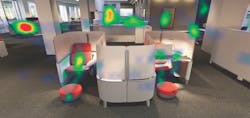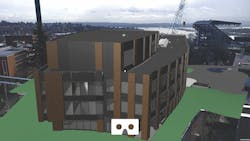Three VR + AR innovations to watch
Is your design catching eyes in the right places?
New VR heat map technology delivers a detailed map of where viewers are paying attention in created VR experiences.
A huge variable when it comes to designing interior spaces is trying to determine where people will actually look when they enter or spend time in a space. In an effort to avoid unintended focal points, some architects and designers use heat mapping as part of their design process to determine what draws a user’s gaze.
Traditional heat mapping techniques rely on a computer screen and a mouse, and assume users will track where they are looking with the mouse. User error—such as when participants look one place but have the mouse cursor placed somewhere else—essentially renders the entire process inaccurate.
A new VR tool from Yulio Technologies is looking to improve heat mapping not by tracking via a mouse, but by analyzing the viewer’s gaze directly. Users are placed in a VR environment, where heat map analytics will track their gaze and map what they are looking at throughout the entire VR session.
With the heat map tool, designers will be able to better understand what catches a viewer’s eye and whether it is intended or not. Architects can test site lines before construction begins. Retailers can test traffic-flow patterns and the effectiveness of displays.
The tool can gather data from both VR headset views and fishtank displays (browser-based mode).
‘Let’s meet in the model’
Vizible, a new VR solution, allows users from around the world to meet in virtual reality—in real time.
Designing and building complex structures is a complicated process that requires the collaboration of many different firms and businesses, oftentimes spread throughout the country or the world. Relaying plans or ideas can be difficult via email, phone, or video calls, and can lead to more confusion than understanding.
Virtual reality, however, may provide a solution to this communication problem. Since VR first started to become a usable tool in the AEC industry, professionals have been dreaming of the day when they could pop on a VR headset and jump into a model for a coordination meeting with other members of the project team or their clients. A new VR solution from WorldViz, called Vizible, is bringing that dream one step closer to reality.
Vizible operates like GoToMeeting for VR and allows designers to create presentations, demos, and mockups via its drag-and-drop interface. Then, the presentation can be uploaded to the secure Vizible cloud and clients can be invited to the meeting via an email.
Once in the meeting, built-in avatars and tools like laser pointers and measuring tapes pinpoint what is being discussed and accurately conveys it to other members of the project team or clients. Multi-region server centers provide a low-latency experience, regardless of where the meeting members are located. Currently, no actual design work can be done while in the meeting, but this is certainly a step in that direction.
Vizible is compatible with the Oculus Rift and HTC Vive headsets.
Mortenson develops AR app for community engagement during construction
A $105 million project for the University of Washington is the latest example of the firm’s commitment to virtual and augmented reality tools.
Mortenson Construction has been in the vanguard of firms using virtual reality as a tool for construction coordination. As far back as 2000, Mortenson’s Seattle office leaned on VDC modeling for the Walt Disney Concert Hall in Los Angeles.
More recently, the firm applied a computerized automatic virtual environment (CAVE) that helped the project team on the Pegula Ice Arena at Penn State University identify changes during the design stage, thereby averting $475,000 in costs.
For the past 18 months, the firm’s Immersive Technology group has been exploring construction-related opportunities for augmented reality. Last year, Mortenson was among the first companies to partner with Daqri to test the application of its “smart” hardhat. And in March, Mortenson went live with what it claims is a first-of-its-kind AR mobile app that allows users to “see” what the new Paul G. Allen Center for Computer Sciences and Engineering building at the University of Washington in Seattle will look like—nearly two years ahead of its scheduled completion.
Marc Kinsman, Mortenson’s Immersive Technology Developer, led the in-house team that created the app. He says its purpose is to generate excitement around the 135,000-sf project among the UW community during construction. The AR mobile app lets users point their smartphones at the construction site, or at a printed handout, to see a digital representation of the future building. Users can experience the exterior via AR, and then use VR to delve deeper into the building’s lobby, workroom, robotics lab, and offices.
“This window presents a tremendous opportunity to engage the public,” says Kinsman, who adds that VR and AR are “vast improvements” over traditional public engagement methods, such as flyers, signage, and websites.




